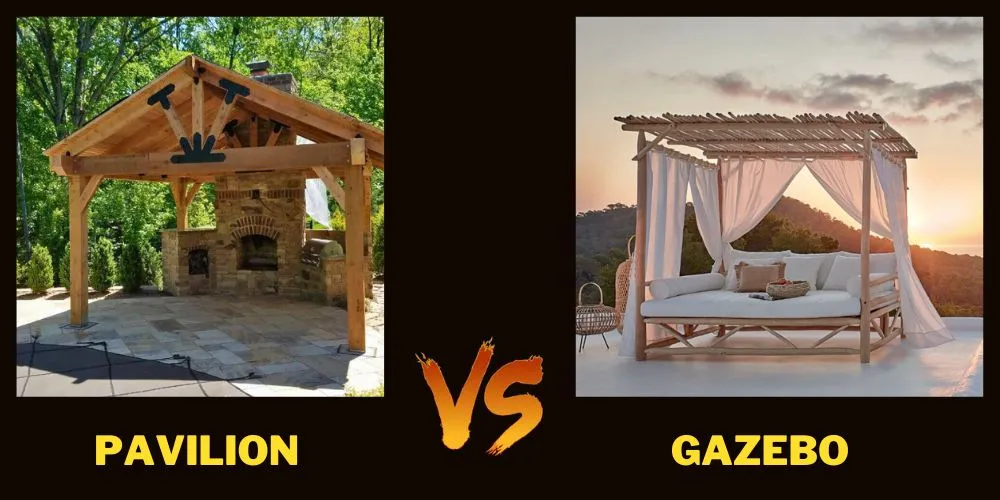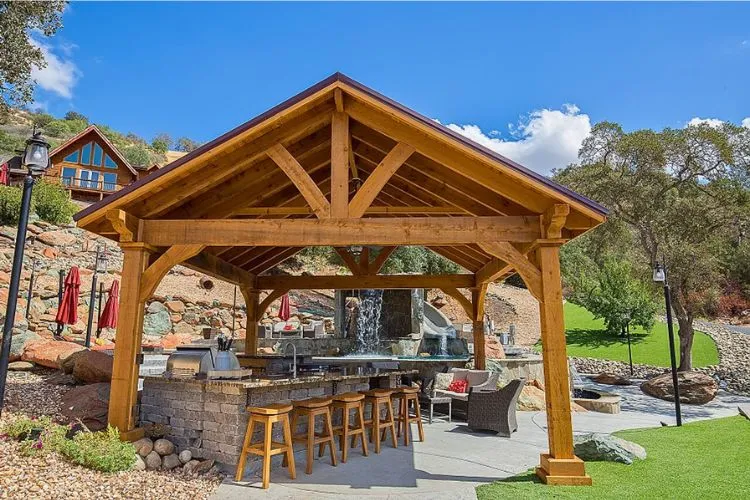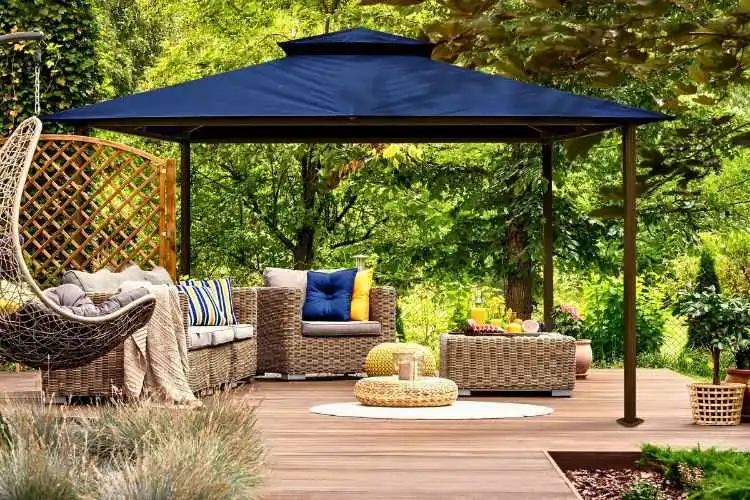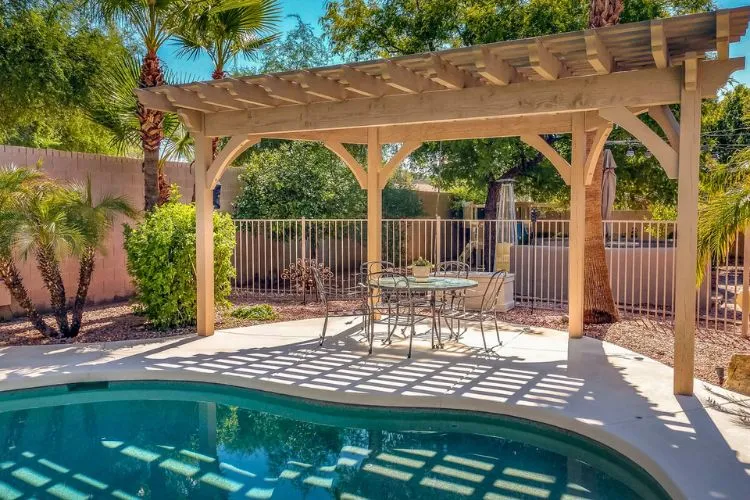When embarking on enhancing your outdoor living space, the decision between installing a pavilion or a gazebo is significant.
Both structures offer distinct benefits and can transform an outdoor setting in unique ways.
This pavilion vs gazebo article dives into each option’s definitions, characteristics, materials, uses, and more, to help you make an informed decision.

Contents
Understanding Pavilions
A pavilion is an open-walled structure often found in parks, large gardens, and public spaces.
These structures provide a shaded area without closed sides, supporting air circulation and accommodating larger groups of people.
Generally, pavilions are rectangular or square, offering a simple yet functional design.

Definition and Key Characteristics
The pavilion’s open plan is designed for versatility, hosting events, picnics, or simply an area for rest.
Its roof offers protection against the sun and rain, making it a year-round option for outdoor gatherings.
Common Materials Used
Materials for pavilions vary, with wood, metal, and vinyl among the most popular choices. Each material offers different aesthetics and longevity.
Wood pavilions blend well with natural surroundings but require regular maintenance. Metal options, like steel or aluminum, offer durability with minimal upkeep.
Vinyl pavilions provide a clean look and are resistant to weathering and pests.
Suitable Locations and Uses
Pavilions excel in spaces meant for larger gatherings or events. Due to their size and open design, they’re perfect for parks, spacious backyards, or near community centers.
Understanding Gazebos
Gazebos are often romanticized in literature and films, and for a good reason. Their octagonal or round shape sets them apart from other garden structures.
With a solid roof and partially open sides, gazebos offer shelter while maintaining a connection with the surrounding landscape.

Definition and Key Characteristics
Gazebos stand out as focal points in gardens and yards. They are designed for smaller, more intimate gatherings or peaceful solitude. The roof provides shade, and the open sides keep the space airy and connected to nature.
Common Materials Used
Wood is a preferred material for gazebos, especially cedar and pine, for their natural beauty and resistance to decay.
Metal gazebos, using wrought iron or aluminum, offer durability and a more formal appearance. Vinyl is chosen for its low maintenance and clean look.
Suitable Locations and Uses
Gazebos fit well in residential areas, beside pools, or in gardens. They serve as havens for relaxation, meditation, or as picturesque spots for meals and small gatherings.
Pavilion vs Gazebo: A Comparison Guide
When choosing between a pavilion and a gazebo, several factors come into play, such as architectural design, functionality, cost, and maintenance.
Architectural Design
Pavilions provide a straightforward design that focuses on functionality and space. Gazebos, with their distinctive shapes and elaborate details, add an element of elegance to a garden or yard.
Functionality
Pavilions provide expansive, open spaces perfect for hosting large-scale events such as weddings, concerts, or community festivals.
Their versatile design accommodates a variety of activities, offering ample room for guests and equipment.
On the other hand, gazebos, with their smaller and more enclosed structure, serve as ideal spots for more intimate gatherings or quiet solitude.
They offer a cozy, sheltered outdoor niche for reading, meditating, or enjoying close conversations, providing both privacy and protection from the elements.
Cost Implications
Initial costs for either structure vary by size, material, and design complexity. Pavilions might cost more due to their larger size.
Maintenance costs also differ, with wood structures requiring more upkeep than metal or vinyl.
Durability and Maintenance
The durability of pavilions and gazebos largely depends on the materials used and the quality of construction.
Regular maintenance can extend the life of both, with specific care needed based on the material.
Pro Tips
Selecting between a pavilion and a gazebo should begin with defining the purpose of the structure. Would you prefer an open space for events or a cozy nook for relaxation?
It’s also vital to check local building codes and consider integrating both if your space allows, offering versatile outdoor living areas.
Case Studies/Examples
Case studies and examples from across the globe underscore the transformative impact of thoughtfully selected pavilions and gazebos on outdoor areas.
For instance, a pavilion situated in the heart of a bustling community park not only offers shelter but evolves into a vibrant center for social events, markets, and public gatherings, fostering a sense of community.

Contrastingly, a gazebo nestled in the serene backdrop of a private garden provides a tranquil retreat, an intimate space for reflection, reading, or enjoying nature’s beauty.
These structures, through their architectural elegance and functionality, significantly enhance the utility and aesthetic appeal of spaces, demonstrating their versatility in both public and private realms.
Frequently Asked Questions (FAQs)
What is more affordable, a pavilion or a gazebo?
The cost depends on size, materials, and design. Generally, gazebos might be less expensive due to their smaller size, but materials and customization can alter costs.
Can pavilions and gazebos be customized?
Yes, both can be tailored to meet specific design preferences and functional needs, influencing the final look and usability.
How long does it take to build a pavilion or gazebo?
Construction time varies based on size, complexity, and whether you choose a pre-fabricated model or custom build. Typically, it ranges from a few days to several weeks.
Which is better for a windy location, a pavilion or a gazebo?
Both structures can be adapted to withstand wind, but securing them properly and choosing designs suitable for windy conditions is crucial.
Do I need a permit to install a pavilion or gazebo?
Permit requirements vary by location, so it’s essential to check local regulations before starting your project.
Conclusion:
Both pavilions and gazebos can significantly impact the functionality and aesthetics of outdoor spaces.
The choice between the two depends on the intended use, space, budget, and personal taste. Understanding the characteristic differences and requirements of each can lead to a decision that enriches your outdoor living experience.
Choosing the right structure for your outdoor space can enhance its beauty and functionality.
By considering the factors outlined in this article, you can make an informed decision that best suits your needs and lifestyle.

Sergio Gomes, a passionate advocate for outdoor living and the male voice behind Shades Authority. With years of experience, Sergio is your trusted source for expert insights on gazebos, pavilions, cabanas, pergolas, and all things outdoor shade solutions. Join him on a journey to transform your outdoor spaces into stunning, functional retreats
